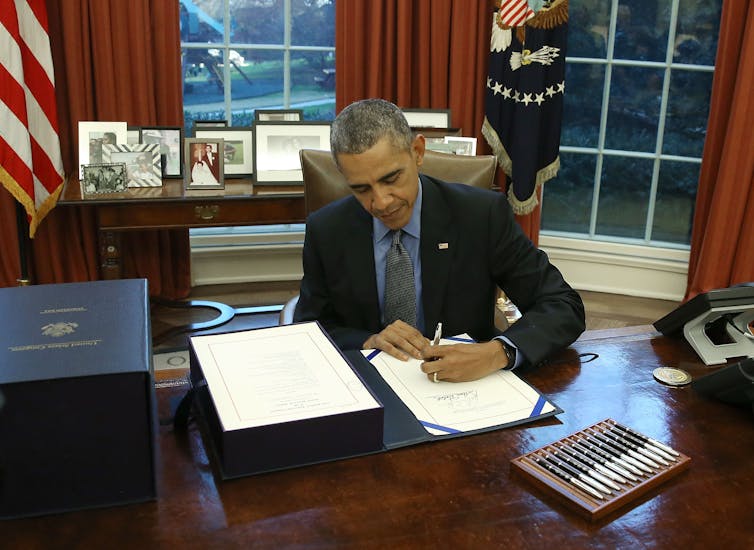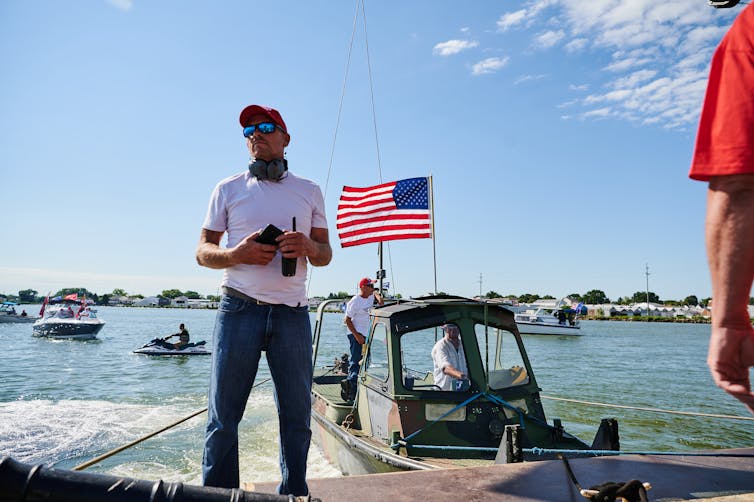
If history holds true to form, I expect the presidential campaigns of Donald Trump and Kamala Harris to begin touting their support for the Great Lakes Restoration Initiative as Election Day approaches.
The Great Lakes Restoration Initiative, or GLRI, is a federal program that funds water and habitat protection and restoration for the Great Lakes, which contain over 20% of the world’s surface freshwater. While voters in some parts of the country may have never heard of it, it is a big deal in the eight states that border these inland seas.
A 2021 poll by the Great Lakes Water Quality Board found that 90% of U.S. and Canadian residents in the region support the lakes’ protection.
But the popularity of the Great Lakes would not have blossomed into such an ambitious and bipartisan conservation effort without another critical fact. Three of those eight surrounding states – Michigan, Wisconsin and Pennsylvania – are critical swing states in 2024. And Ohio, although no longer considered a swing state, had been one until 2016.
As a scholar of water policy and politics at the University of Michigan’s School for Environment & Sustainability, and a former leader in the Great Lakes advocacy community, I have championed Great Lakes protection and studied the impact of advocacy on policy and funding.
I have seen how politicians and conservationists deftly use the region’s political battleground status to draw support for Great Lakes restoration from presidential candidates from both major parties. And I believe this is unlikely to change in 2024 and beyond.
Fighting ‘Everglades envy’
The Great Lakes are considered a uniting force among residents of the region, thanks to their iconic nature, recreational value and the drinking water they provide to over 40 million people.
This broad and deep regard, however, was not enough to protect the Great Lakes from extreme degradation throughout the 20th century.
Time magazine declared Lake Erie “dead” in a 1970 article that included an iconic cover photo of a fire burning on the surface of Cleveland’s Cuyahoga River. This media coverage, following decades of pollution of the Great Lakes, helped to both kick-start the U.S. environmental movement and pave the way for passage of the Clean Water Act in 1972.
But in 2000, when the Florida Everglades ecosystem – which sits in what was a key swing state at the time – received over US$4 billion in federal funding for a massive cleanup, the Great Lakes still didn’t have the resources for even basic remediation of toxic sites.
This led many in the region to suffer from what I heard many lawmakers and others describe as “Everglades envy.” They shared maps of how the entire Everglades ecosystem could fit into one corner of the Great Lakes. More importantly, they plotted how to get funding to clean up toxic hot spots, restore degraded habitats, expand recreational access and educate the next generation of Great Lakes leaders.
George W. Bush’s executive order
When President George W. Bush’s 2004 reelection team wanted to secure the electoral college votes of Ohio, Michigan and Wisconsin, regional lawmakers and advocates helped them craft an executive order. It declared the lakes a “national treasure” and required federal agencies to work together on a “regional collaboration of national significance for the Great Lakes.”
That same year, philanthropist Peter Wege gave $2.5 million to launch the Healing Our Waters – Great Lakes Coalition. The coalition brought together nonprofits in the region to collectively advocate for cleaning up the lakes.
After Bush’s reelection, his executive order was used to organize over 1,500 diverse stakeholders into eight strategy teams. These teams created a $20 billion plan for restoring the Great Lakes.
However, the plan existed only on paper – until the presidential campaigns of 2008, when advocates and political leaders leveraged the swing state status of Michigan, Ohio and Wisconsin to garner support for funding the cleanup plan.
As a result, Sen. Barack Obama’s and Sen. John McCain’s presidential campaigns declared their commitment to Great Lakes restoration.
Obama launches GLRI
After winning all eight Great Lakes states in 2008, Obama used stimulus funds to launch the Great Lakes Restoration Initiative in 2010.
With an initial congressional appropriation of $475 million in 2010, and nearly $300 million in each of the following two years, it was one of the rare times Obama’s proposed budget aligned with Republican priorities in Congress.
In the run-up to the 2012 presidential election, both Obama and Massachusetts Gov. Mitt Romney, the Republican presidential nominee whose father was a former governor of Michigan, declared their support for Great Lakes restoration. This came after the Healing Our Waters coalition pressed both campaigns to pledge to fund GLRI and to stop invasive species from reaching the Great Lakes via the Chicago River.

After the 2012 election, the Great Lakes Restoration Initiative continued to receive approximately $300 million per year and strong support in Congress. When Obama proposed modest cuts to the program during his second term, Republicans and Democrats united to restore the funding. The Great Lakes Restoration Initiative inspired “rare bipartisanship,” as The Associated Press reported at the time.
Trump moves to eliminate funding
In the 2016 election, representatives for both Trump and his Democratic rival, Hillary Clinton, pledged support for Great Lakes restoration during the annual meeting of the Healing Our Waters coalition in Sandusky, Ohio. The Trump team, however, was ambiguous about the funding level it supported.
Once in office, Trump reversed course and proposed eliminating all funding for the initiative.
Congress, led by bipartisan members of the Great Lakes Congressional Task Force – including U.S. Rep. David Joyce and U.S. Sen. Rob Portman, Ohio Republicans who held powerful appropriations positions – fought back fiercely and restored the funding.
In 2018 and 2019, Trump’s budgets proposed cutting funding for the initiative by 90%. But again, with strong bipartisan support, it was restored to levels nearing $300 million per year.
By 2020, concerns tied to his reelection prospects changed Trump’s approach.

Trump’s turning point
The famous turning point allegedly came during a car ride to a West Michigan campaign rally in 2019 when Republican U.S. Rep. Bill Huizenga emphasized the importance of the Great Lakes to Michigan politics.
At the rally, Trump reversed his previous position and announced that he would fully fund the GLRI at $300 million per year.
He went further: “I support the Great Lakes. Always have. They’re beautiful. They’re big. Very deep. Record deepness, right? … We’re going to make the Great Lakes great again.”
In response, Michigan Democratic U.S. Rep. Dan Kildee quipped, “The President claiming to support the Great Lakes is like an arsonist congratulating themselves for putting out a fire they started.”
Regardless, Trump’s shift helped the restoration initiative reach $320 million in funding in the 2021 budget – the first time it topped $300 million since its first year.
On the campaign trail in 2020, both Trump and Democratic presidential nominee Joe Biden highlighted their support for GLRI during swing state stops in the upper Midwest. Biden ultimately won all three of the current Great Lakes swing states and strongly supported the GLRI while in office too.
In 2021, he signed into law the bipartisan Infrastructure Investment and Jobs Act, which included $1 billion in additional GLRI funding over five years. With this boost, funding for the initiative reached nearly $550 million in 2022, its highest ever.
Bipartisan litmus test
Since its launch in 2010, the GLRI has funded over 7,500 projects to clean up polluted waterways, restore habitats, control invasive species, reduce polluted runoff, improve recreational access and educate the public.
Great Lakes pollution remains a complex problem, however, and climate change further complicates cleanup efforts.
The Biden administration has repeatedly emphasized and implemented its commitment to the Great Lakes specifically and water infrastructure generally.
And in the current race, both vice presidential candidates are from the region. In 2023, U.S. Sen. JD Vance of Ohio became the Republican co-chair of the Great Lakes Congressional Task Force. He has supported legislation to increase funding for the GLRI.
Minnesota Gov. Tim Walz, Harris’ running mate on the Democratic ticket, briefly referenced the Great Lakes’ freshwater supply during the Oct. 1, 2024, vice presidential debate. He too has strongly supported efforts to restore them during his time in office.
Although Great Lakes restoration has not yet played a major public role in either Trump’s or Harris’ 2024 campaign, history tells us that the issue plays well politically in key swing states in the upper Midwest. In fact, it has become a rare bipartisan litmus test of allegiance to this politically divided and critically important region.
Mike Shriberg was previously the Great Lakes Regional Executive Director of the National Wildlife Federation, which entailed being a co-chair (and, for part of the time, Director) of the Healing Our Waters - Great Lakes Coalition that is referenced in the article.
This article was originally published on The Conversation. Read the original article.







